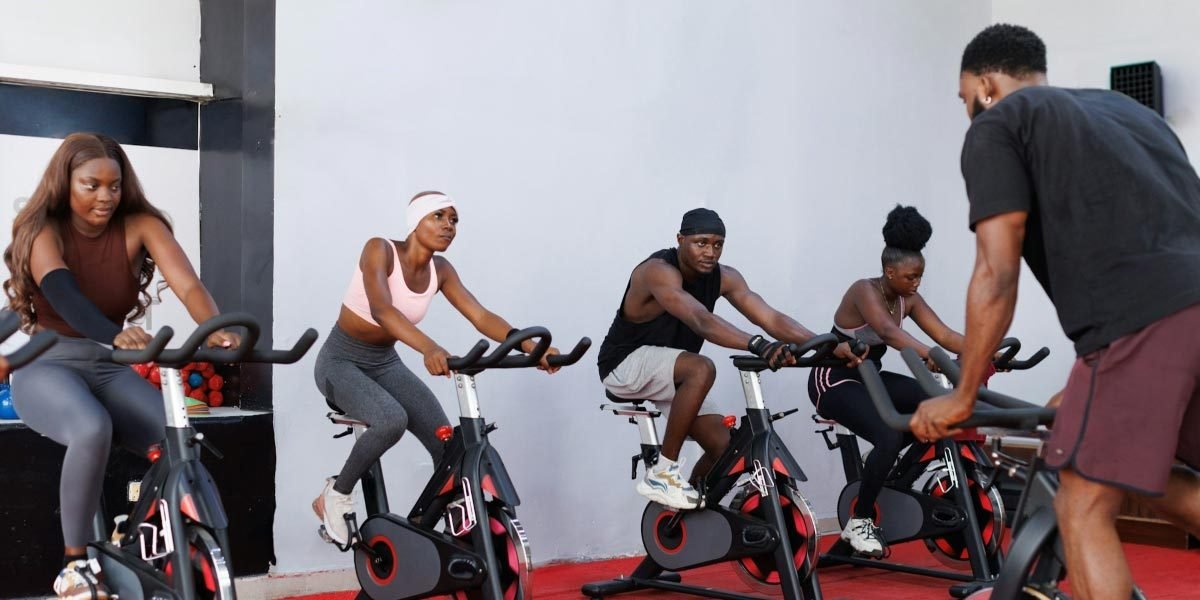Spinning classes have become a staple in modern fitness routines, captivating millions of people around the world. Once a niche activity, spinning—also known as indoor cycling—has grown into a mainstream fitness trend that appeals to individuals of all fitness levels. From its origins as a high-intensity cycling workout to its place in the world of boutique fitness studios, spinning has evolved into a dynamic and accessible form of exercise. This article explores the factors contributing to the rising popularity of spinning classes, from the physical and mental benefits to the role of technology and the sense of community that defines the experience.
Read also: The Relation Between Fashion and Graffiti Culture
Origins of Spinning
History of Spinning
Spinning as we know it today originated in the 1980s, created by South African cyclist Jonathan Goldberg (known as Johnny G). After an accident that forced him to reimagine his cycling routine, he developed a way to simulate outdoor cycling indoors. This led to the creation of the first stationary bike designed specifically for high-intensity interval training (HIIT). His innovation quickly gained popularity, and spinning classes began to proliferate across fitness clubs worldwide.
Evolution of Indoor Cycling
Indoor cycling was not a new concept, but the introduction of Johnny G’s innovative cycling classes marked the beginning of the spinning revolution. Traditional cycling classes were typically slower-paced and less intense, but spinning focused on simulating outdoor cycling experiences, including hills, sprints, and endurance challenges. This marked a significant shift, turning indoor cycling into a highly effective cardiovascular workout.
The Role of Founders and Early Influencers
Spinning’s early success can also be attributed to the influencers and fitness enthusiasts who helped popularize the concept. Johnny G’s creation was soon embraced by trainers and fitness clubs, and through word-of-mouth and positive media coverage, spinning classes quickly gained traction. Over time, cycling became more than just a fitness activity—it became a community-driven movement that transformed the way people approached indoor fitness.
The Benefits of Spinning
Physical Health Benefits
Spinning is widely recognized for its cardiovascular benefits, providing an intense, full-body workout that improves stamina, strength, and endurance. It primarily targets the lower body, engaging muscles in the legs, glutes, and core. Regular spinning sessions help burn calories, promote fat loss, and build muscle, making it a powerful tool for weight management and overall fitness.
Additionally, spinning is a low-impact exercise, making it an ideal choice for people with joint issues or those recovering from injuries. It provides a safe alternative to higher-impact exercises like running while still delivering a challenging and effective workout.
Mental Health Benefits
Beyond the physical, spinning also offers substantial mental health benefits. The intense, rhythmic nature of the workout helps to reduce stress, improve mood, and increase feelings of well-being. Many participants report a sense of euphoria after class, thanks to the release of endorphins during the workout.
Spinning is also known to help with mental focus and clarity. The combination of cycling movements, breathing techniques, and music helps participants achieve a “flow state,” where they feel completely immersed in the workout, pushing through mental barriers and achieving a sense of accomplishment.
The Appeal of Spinning Classes
High-Intensity Workouts
One of the main reasons spinning has gained popularity is its high-intensity nature. The classes combine endurance training, strength-building, and HIIT principles into one dynamic workout. The fast-paced nature of the class allows participants to challenge themselves while benefiting from a full-body workout. Whether it’s climbing a simulated hill or sprinting on flat terrain, the intensity of the workout keeps participants engaged and motivated.
Accessibility for All Fitness Levels
Spinning has wide appeal because it is suitable for people of all fitness levels. The adjustable resistance on the stationary bikes allows participants to modify the intensity of their workout according to their ability. Beginners can start at a comfortable pace, while experienced cyclists can push themselves to their limits. This adaptability makes spinning classes accessible and inclusive, encouraging people of all fitness backgrounds to participate and improve their health.
Sense of Community
Another compelling factor behind the popularity of spinning is the strong sense of community it fosters. Many spinning studios and fitness centers promote a social, group-oriented experience. Group cycling classes provide an opportunity for participants to bond over a shared workout, offering motivation and accountability. The sense of camaraderie among participants can be a powerful motivator, making people more likely to return and stay committed to their fitness goals.
The Impact of Group Fitness
Group Motivation and Accountability
Spinning classes are inherently social, and the collective energy of a group workout can drive participants to perform at their best. The encouragement from both the instructor and fellow participants enhances motivation, pushing individuals to work harder than they might in a solo workout. The group dynamic fosters a sense of accountability—knowing that others are expecting you to show up can make it easier to stick to a fitness routine.
Energy Boost from Group Dynamics
The positive energy generated in a group setting can create a highly charged atmosphere, where participants feel energized and inspired. This heightened energy levels not only boost the workout but also create a sense of fun and excitement. Group cycling classes often feature motivational cues, upbeat music, and a lively atmosphere, all of which contribute to the overall experience.
Competitive Nature of Group Settings
The competitive aspect of group fitness also plays a role in the appeal of spinning. Instructors often challenge participants to push their limits, motivating them to “beat their personal best” or compete against others in the class. While not every participant may thrive on competition, the intensity of the group setting can encourage a sense of friendly rivalry that drives performance.
Technological Advancements in Spinning
Use of Smart Bikes and Wearable Tech
As technology has advanced, spinning classes have become increasingly interactive. The integration of smart bikes with digital tracking systems allows participants to monitor their progress in real time. Devices such as heart rate monitors, cadence trackers, and power meters help cyclists track their performance and see improvements over time. This use of wearable tech adds an extra layer of motivation for participants, who can track their fitness progress and set personal goals.
Integration of Virtual Spinning Classes
In response to the rise of digital fitness trends, virtual spinning classes have become more popular. Online platforms and apps offer access to live and on-demand spinning classes, allowing people to cycle from the comfort of their homes. Virtual classes have broadened the reach of spinning, making it accessible to individuals who may not have access to physical studios or who prefer to work out in private.
App-Based Programs and Tracking Progress
Many spinning enthusiasts now use apps to track their cycling data, connect with other users, and participate in challenges. These apps offer features like leaderboards, progress tracking, and personalized workout recommendations, helping users stay engaged and motivated. The fusion of fitness and technology has transformed spinning into a more interactive and data-driven experience.
Spinning in the Digital Age
The Growth of Virtual Spinning Platforms
With the rise of virtual spinning platforms like Peloton and Zwift, the popularity of spinning has expanded beyond traditional gyms. These platforms allow users to join cycling classes led by expert instructors, providing a high-quality workout experience at home. The ability to participate in global cycling communities has increased the accessibility of spinning, making it possible for people to connect with others from all over the world.
Online Communities and Global Instructors
Virtual platforms also create opportunities for cycling enthusiasts to engage with instructors and participants globally. Online communities have fostered a sense of belonging and mutual support, motivating individuals to stay consistent in their fitness routines. Additionally, users have access to a wide range of instructors, offering diverse teaching styles and workout formats, which helps keep the experience fresh and engaging.
The Role of Music in Spinning Classes
The Importance of Music and Rhythm
Music plays an integral role in spinning classes, enhancing both the physical and emotional experience of the workout. Upbeat, high-energy music helps keep participants motivated, sets the pace for the workout, and adds to the overall enjoyment. Instructors often carefully curate playlists to match the intensity of the workout, using rhythm to drive the pace and inspire effort.
Role of Music in Enhancing the Workout Experience
The right music can transform a spinning class, boosting participants’ energy and engagement. The synergy between cycling movements and rhythm not only enhances performance but also helps participants enter a flow state, where they feel fully immersed in the workout.
Use of DJ-Driven Classes
Some spinning classes have embraced live DJ performances or playlists curated by professional DJs. These sessions create an electrifying atmosphere, where participants feel as though they are at a high-energy music event rather than just a workout.
Read also: Why Couples Love to Match Clothes
Future Trends in Spinning
Evolving Workout Formats
As fitness trends continue to evolve, the format of spinning classes is likely to evolve as well. New cycling techniques, combined with technological advances, will continue to shape the future of spinning. Hybrid formats that incorporate strength training, yoga, or dance may also become more common, creating a more dynamic, full-body workout experience.
The Continued Integration of Technology and Wellness
The future of spinning will likely see even more integration of technology and wellness. From advanced tracking systems to virtual reality experiences, the possibilities for combining fitness with cutting-edge technology are endless. As the fitness industry continues to innovate, spinning will remain at the forefront of these changes, offering a highly engaging and personalized workout experience.
Spinning classes have become a fitness phenomenon due to their combination of high-intensity workouts, mental health benefits, and social aspects. From their origins as a niche activity to their integration with digital platforms and wearable tech, spinning has evolved to meet the needs of modern fitness enthusiasts. As the trend continues to grow, it will undoubtedly shape the future of fitness, offering individuals a fun, effective, and community-driven way to stay healthy and motivated.








